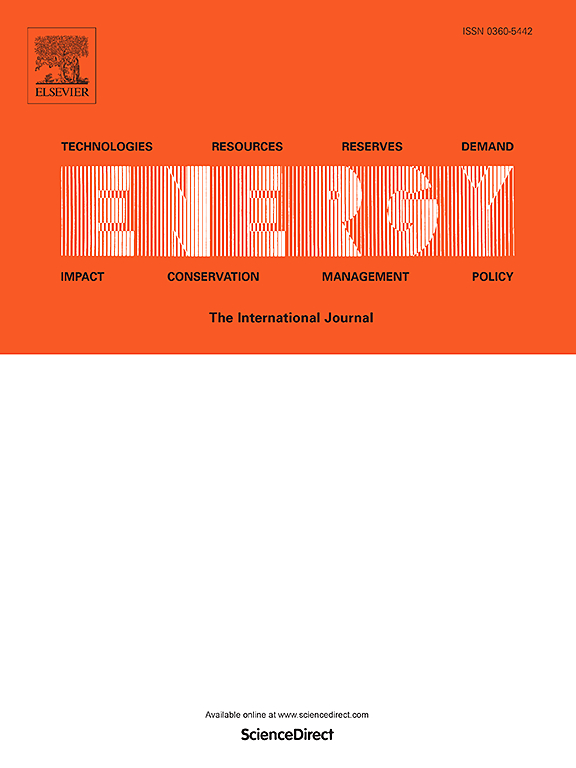Transient multi-field catalytic mechanism of derived CO in deep energy extraction and optimization of synergistic conversion efficiency
IF 9
1区 工程技术
Q1 ENERGY & FUELS
引用次数: 0
Abstract
In deep coal fluidized energy extraction, complex geological conditions and nonlinear fluctuations heighten risks of gas explosions and CO diffusion. This study proposes a Transient Multifield-Catalytic Synergistic (TMFCS) technology utilizing micro-nano particles, integrating particle catalysis experiments with a coupled thermal-flow-solid-reaction model to establish rapid CO conversion. The dynamic diffusion mechanisms of internally excited particle clouds and their impacts on component conversion efficiency are systematically analyzed for in-situ carbon conversion and explosion-induced smoke-gas diffusion control. Experimental results demonstrate that under catalytic particle sizes of 50–75 μm and delayed release times of 12–22 ms, the TMFCS achieves over 70 % in-situ CO conversion. To enhance prediction accuracy in complex conditions, a hybrid model combining Convolutional Neural Network (CNN), Bidirectional Long Short-Term Memory Network (BiLSTM), and Attention mechanisms is developed. Integrated with the Grey Wolf Optimizer (GWO) algorithm, optimal catalytic particle parameters and spraying processes are inversely identified, elevating CO conversion rates beyond 79 %. The TMFCS framework enables rapid CO consumption during deep mining, offering theoretical and technical foundations for carbon resource recycling and safety control. This approach addresses challenges in waste carbon utilization and explosion prevention, advancing sustainable and secure energy extraction practices.
衍生CO在深层能源提取中的瞬态多场催化机理及协同转化效率优化
在深部煤流化能源开采中,复杂的地质条件和非线性波动增加了瓦斯爆炸和CO扩散的风险。本研究提出了一种利用微纳粒子的瞬态多场催化协同(TMFCS)技术,将粒子催化实验与热流-固相耦合反应模型相结合,建立快速CO转化。系统分析了内激发粒子云的动态扩散机制及其对成分转化效率的影响,用于原位碳转化和爆炸烟气扩散控制。实验结果表明,在催化粒径为50 ~ 75 μm、延迟释放时间为12 ~ 22 ms的条件下,TMFCS的原位CO转化率达到70%以上。为了提高复杂条件下的预测精度,建立了卷积神经网络(CNN)、双向长短期记忆网络(BiLSTM)和注意机制相结合的混合模型。与灰狼优化器(GWO)算法相结合,优化催化颗粒参数和喷涂过程逆向识别,将CO转化率提高到79%以上。TMFCS框架实现了深部开采过程中CO的快速消耗,为碳资源回收和安全控制提供了理论和技术基础。这种方法解决了废碳利用和防爆方面的挑战,促进了可持续和安全的能源开采实践。
本文章由计算机程序翻译,如有差异,请以英文原文为准。
求助全文
约1分钟内获得全文
求助全文
来源期刊

Energy
工程技术-能源与燃料
CiteScore
15.30
自引率
14.40%
发文量
0
审稿时长
14.2 weeks
期刊介绍:
Energy is a multidisciplinary, international journal that publishes research and analysis in the field of energy engineering. Our aim is to become a leading peer-reviewed platform and a trusted source of information for energy-related topics.
The journal covers a range of areas including mechanical engineering, thermal sciences, and energy analysis. We are particularly interested in research on energy modelling, prediction, integrated energy systems, planning, and management.
Additionally, we welcome papers on energy conservation, efficiency, biomass and bioenergy, renewable energy, electricity supply and demand, energy storage, buildings, and economic and policy issues. These topics should align with our broader multidisciplinary focus.
 求助内容:
求助内容: 应助结果提醒方式:
应助结果提醒方式:


